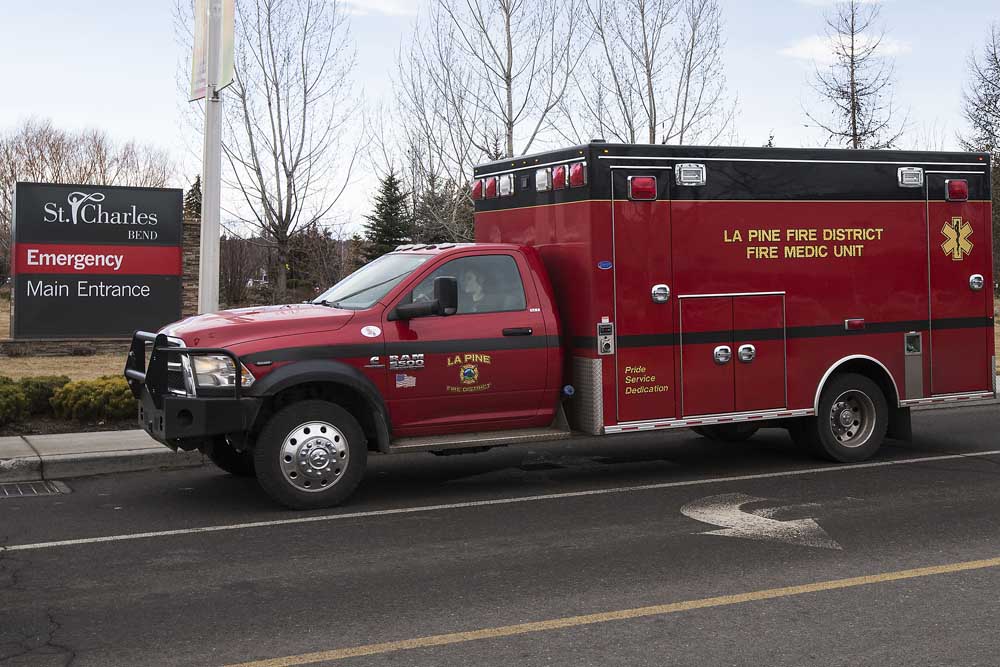La Pine fire district now charging St. Charles for ambulance trips to Bend
Published 5:00 am Monday, February 3, 2020

- A La Pine Rural Fire Protection District ambulance leaves St. Charles Bend campus after taking a patient to the emergency room in 2020.
It happens a few times each week. A person walks into the St. Charles Health System clinic in La Pine with chest pains or a sprained ankle or other condition requiring care the clinic can’t provide, and a clinic doctor orders the patient transferred to St. Charles’ main hospital in Bend, 35 miles away.
To deliver the patient, the doctor calls the only advanced life support ambulance service in the La Pine area: the La Pine Rural Fire Protection District, which has two ambulances in its fleet.
In 2019, the La Pine Fire Protection District performed around 150 of these “interagency transports” from the La Pine clinic to St. Charles Bend. But these trips are costly — about $2,000 each — and tie up two professional firefighter-paramedics for about two hours. They also involve La Pine’s two neighbor districts, Cascade Rural Fire Protection District or Sunriver Fire Department, which under a mutual aid agreement must cover for La Pine during its excursions to Bend.
It’s all a bit of overkill, according to La Pine fire chief Mike Supkis.
“It’s like using an aircraft carrier to go fishing, or calling the Navy SEALs to write parking tickets,” he said. “We’re good, but we’re expensive.”
The cost of these nonemergency ambulance rides to Bend has traditionally been borne by the patient, or, very rarely, the patient’s insurer. But now, two years after St. Charles opened the La Pine clinic, and following nine months of public discussion, the fire district’s board has approved a policy taking the cost off the patient and putting it on St. Charles.
It’s a novel approach to an emerging crisis in rural emergency medical service. The ordinance went into effect Jan. 1, though Supkis said it’s too early to tell if it’s had an impact.
“This protects our taxpayers and it protects the patient, because the doctor is the one making these decisions, and they need to be responsible for them,” Supkis said. “We’re not telling them they can or they can’t, we’re just telling them that now, they own it.”
The district was formed in 1990 and today has a $4.5 million budget and 28 career firefighter-paramedics to protect a vast service area.
St. Charles opened the La Pine Immediate Care clinic in 2018, part of a broader push to expand health care into rural parts of fast-growing Central Oregon. As part of strategic planning, St. Charles officials had analyzed patient data in the Bend immediate care clinics and saw a high number of patients were residents of La Pine. Today, it and the La Pine Family Care Clinic see between 700 and 900 patients per month, and 10,000 per year.
The clinic was intended to serve patients suffering from conditions they would typically take to a primary care physician — coughs, colds, flus and minor burns and fractures. The La Pine fire district’s increased transport workload is an unintended consequence, St. Charles officials said.
“I think they had a hope that when we opened a clinic, it would reduce their workload and reduce the need for transports,” said Mike Richards, interim president of St. Charles Medical Group. “But I think the fact of the matter is that by having more readily available access to health care for the patients and the community, we’re identifying more need for transports. We’re identifying more issues in patients that might not have been picked up before.”
Hospital officials note patient transports represent less than 2% of the clinic’s total patients. The health system is working with its clinic doctors on ways to pare down that number, but it’s hard to make across-the-board policies when each patient is unique, said Danielle Baughman, St. Charles director of clinic operations.
“Every patient has different health histories, different diagnoses, that’s a case-by-case decision made by the provider,” she said.
It also isn’t easy, given a doctor’s ethical obligations to patients, Richards said.
“It’s true they might ask for a transport on a patient who maybe could have driven themself (to St. Charles Bend). But, you send 10 patients like that, and one of them might have a bad outcome,” Richards said.
St. Charles has produced and distributed brochures entitled, “Know Where to Go,” to help save La Pine residents unnecessary trips. But officials admit it might have to ramp up public education efforts.
“We’re looking at all options at this point. A longer -term solution, obviously, would be to increase the level of care in the clinic,” Richards said.






